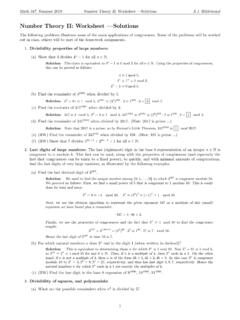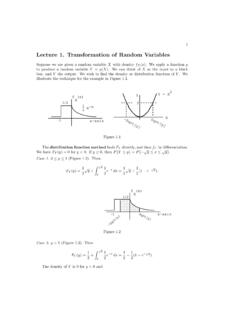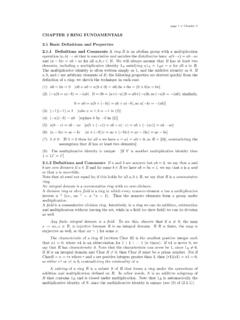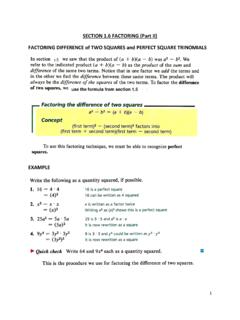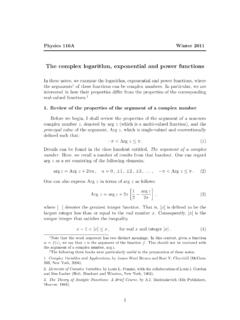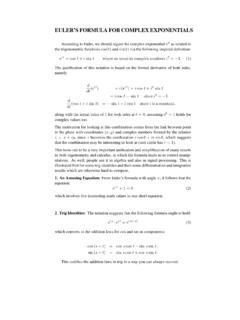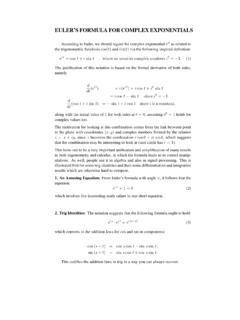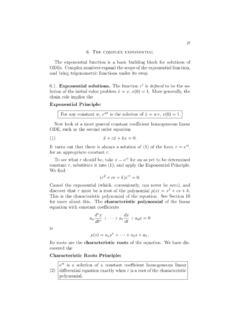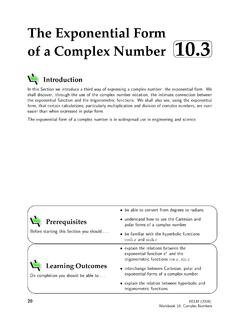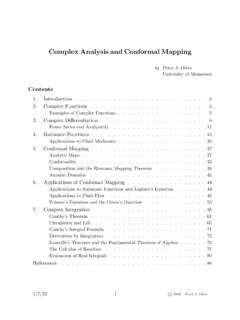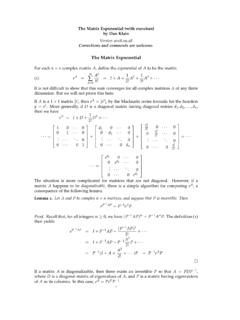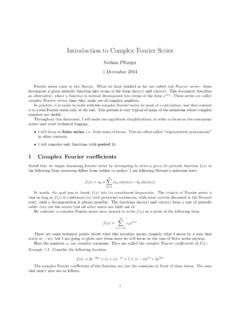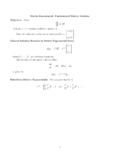Transcription of An Introduction to Complex Analysis and Geometry
1 An Introduction to Complex Analysis and GeometryJohn P. D AngeloDept. of Mathematics, Univ. of Illinois, 1409 W. Green St., Urbana IL 2009 by John P. D AngeloContentsChapter 1. From the real numbers to the Complex numbers111. Introduction112. Number systems113. Inequalities and ordered fields164. The Complex numbers245. Alternative definitions ofC266. A glimpse at metric spaces30 Chapter 2. Complex numbers351. Complex conjugation352. Existence of square roots373. Limits394. Convergent infinite series415. Uniform convergence and consequences446. The unit circle and trigonometry507. The Geometry of addition and multiplication538. Logarithms54 Chapter 3. Complex numbers and geometry591.
2 Lines, circles, and balls592. Analytic geometry623. Quadratic polynomials634. Linear fractional transformations695. The Riemann sphere73 Chapter 4. Power series expansions751. Geometric series752. The radius of convergence783. Generating functions804. Fibonacci numbers825. An application of power series856. Rationality87 Chapter 5. Complex differentiation911. Definitions of Complex analytic function912. Complex differentiation923. The Cauchy-Riemann equations944. Orthogonal trajectories and harmonic functions975. A glimpse at harmonic functions986. What is a differential form?10334 CONTENTSC hapter 6. Complex integration1071. Complex -valued functions1072. Line integrals1093.
3 Goursat s proof1164. The Cauchy integral formula1195. A return to the definition of Complex analytic function124 Chapter 7. Applications of Complex integration1271. Singularities and residues1272. Evaluating real integrals using Complex variables methods1293. Fourier transforms1364. The Gamma function138 Chapter 8. Additional Topics1431. The minimum-maximum theorem1432. The fundamental theorem of algebra1443. Winding numbers, zeroes, and poles1474. Pythagorean triples1525. Elementary mappings1556. Quaternions1587. Higher dimensional Complex analysis160 Further reading163 Bibliography165 Index167 CONTENTS5 PrefaceThis book developed from a course given in the Campus Honors Program at theUniversity of Illinois Urbana-Champaign in the fall semester 2008.
4 The aims of thecourse were to introduce bright students, most of whom were freshmen, to complexnumbers in a friendly, elegant fashion and to develop reasoning skills belonging tothe realm of elementary Complex Geometry . In the spring semester 2010 I taughtanother version of the course, in which a draft of this book was available on-line. Itherefore wish to acknowledge the Campus Honors Program at UIUC for allowingme to teach these courses and to thank the 27 students who participated in elementary mathematics and physics problems seem to simplify magicallywhen viewed from the perspective of Complex Analysis . My own research interestsin functions of several Complex variables and CR Geometry have allowed me towitness this magic daily.
5 I continue the preface by mentioning some of the specifictopics discussed in the book and by indicating how they fit into this discussion of Complex Analysis must spend considerable time with powerseries expansions. We include enough basic Analysis to study power series rigorouslyand to solidify the backgrounds of the typical students in the course. In some sensetwo specific power series dominate the subject: the geometric and geometric series appears all throughout mathematics and physics, and evenin basic economics. The Cauchy integral formula provides a way of deriving fromthe geometric series the power series expansion of an arbitrary Complex analyticfunction. Applications of the geometric series appear throughout the exponential series is of course also crucial.
6 We define the exponentialfunction via its power series, and we define the trigonometric functions by way ofthe exponential function. This approach reveals the striking connections betweenthe functional equationez+w=ezewand the profusion of trig identities. Usingthe Complex exponential function to simplify trigonometry is a compelling aspectof elementary Complex Analysis and Geometry . Students in my courses seemed toappreciate this material to a great of the most appealing combinations of the geometric series and the expo- nential series appears in Chapter 4. We combine them to derive a formula for thesumsn j=1jp,in terms of Bernoulli briefly discuss ordinary and exponential generating functions, and we findthe ordinary generating function for the Fibonacci numbers.
7 We then derive Bi-net s formula for then-th Fibonacci number and show that the ratio of successiveFibonacci numbers tends to the golden ratio1+ early in the book (Chapter 3) we discuss hyperbolas, ellipses, and parabo-las. Most students have seen this material in calculus or even earlier. In order tomake the material more engaging, we describe these objects by way of Hermitiansymmetric quadratic polynomials. This approach epitomizes our focus on complexnumbers rather than on pairs of real Geometry of the unit circle also allows us to determine the Pythagoreantriples. We identify the Pythagorean triple (a,b,c) with the Complex numberac+ibc;we then realize that a Pythagorean triple corresponds to a rational point (in the firstquadrant) on the unit circle.
8 After determining the usual rational parametrizationof the unit circle, one can easily find all these triples. But one gains much more; forexample, one discovers the so-called tan( 2) substitution from calculus. During thecourse several students followed up this idea and tracked down how the indefiniteintegral of the secant function arose in book is more formal than was the course itself. The list of approximatelytwo hundred eighty exercises in the book is also considerably longer than the list ofassigned exercises. These exercises are numbered by Chapter, whereas items suchas Theorems, Propositions, and Definitions are numbered by Section. The overalldevelopment in the book closely parallels that of the courses, although each timeI omitted many of the harder topics.
9 I feel cautiously optimistic that this bookcan be used for similar courses. Instructors will need to make their own decisionsabout which subjects can be omitted. I hope however that the book has a wideraudience including anyone who has ever been curious about Complex numbers andthe striking role they play in modern mathematics and 1 starts by considering various number systems and continues by de-scribing, slowly and carefully, what it means to say that the real numbers area complete ordered field. We give an interesting proof that there is norationalsquare root of 2, and we prove carefully (based on the completeness axiom) thatpositive real numbers have square roots. The chapter ends by giving several possibledefinitions of the field of Complex 2 develops the basic properties of Complex numbers, with a special em-phasis on the role of Complex conjugation.
10 The author s own research in complexanalysis and Geometry has often usedpolarization; this technique makes precise thesense in which we may treatzandzas independent variables. We will view complexanalytic functions as those independent ofz. In this chapter we also include pre-cise definitions about convergence of series and related elementary Analysis . Someinstructors will need to treat this material carefully, while others will wish to re-view it quickly. Section 5 treats uniform convergence and some readers will wishto postpone this material. The subsequent sections however return to the basics ofcomplex Geometry . We define the exponential function by its power series and thecosine and sine functions by way of the exponential function.




